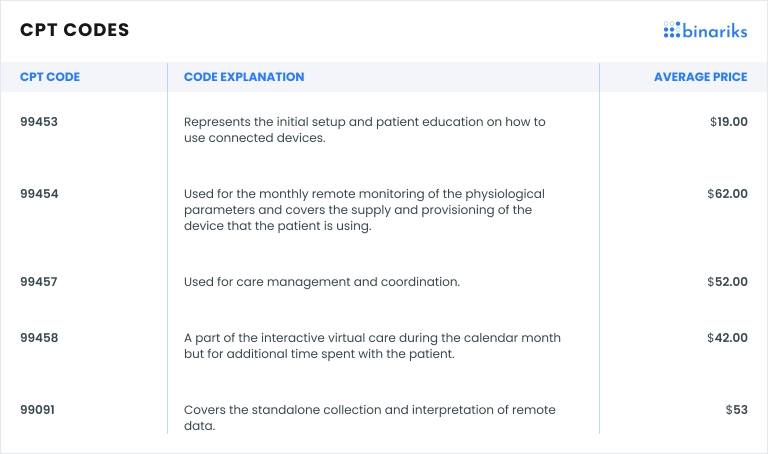In modern medicine, RPM has emerged as a transformative solution, enabling healthcare providers to monitor patients' health conditions remotely.
As technology advances, so do the coding systems that help streamline the reimbursement process for these services. In 2023, significant changes have been implemented in the realm of RPM CPT codes, bringing forth new opportunities and challenges for healthcare professionals.
At Binariks, we understand the significance of these changes and the impact they have. With our expertise in developing RPM solutions, we aim to shed light on the CPT codes, and their descriptions and provide valuable tips for proper use.
Our comprehensive guide will equip you with the knowledge to navigate the Remote Patient Monitoring CPT codes and effectively utilize them to enhance patient care and optimize reimbursement processes.
What are RPM CPT codes?
The American Medical Association (AMA) has developed specific Current Procedural Terminology (CPT) codes to streamline the RPM reimbursement process.
CPT codes for remote patient monitoring are standardized codes used to identify and bill for the various remote monitoring services provided to patients. These codes are a common language between healthcare providers and payers, facilitating accurate billing and reimbursement for RPM services (source ).
However, not all remote monitoring services qualify for reimbursement under these codes. According to the Centers for Medicare and Medicaid Services (CMS) regulations, RPM services must meet specific criteria to be eligible for reimbursement (source ). These criteria include:
- Verifiable Patient Consent: Patients must provide documented consent for remote monitoring services, acknowledging their understanding and agreement to participate.
- Medical Necessity: RPM services must be medically necessary for the patient's condition and align with the established guidelines and protocols.
- Continuous Monitoring: Remote monitoring must involve collecting and transmitting patient health data continuously, enabling healthcare providers to proactively assess and manage the patient's health.
- Qualified Healthcare Professional: The RPM services must be overseen by a qualified healthcare professional who actively monitors and reviews the collected data, making informed clinical decisions.
The most relevant RPM CPT codes for 2026
Here is an overview of the key RPM CPT codes for 2026, along with relevant explanations for them:

Now, let's delve more deeply into each of these RPM CPT codes:
CPT code 99453
This code pertains to the remote monitoring of various physiologic parameters, such as weight, blood pressure, pulse oximetry, and respiratory flow rate. It encompasses the initial setup of connected devices and patient education on their usage, including guidance on when and how to take measurements.
It is billed as a one-time code when a patient enrolls in a remote monitoring program under the recommendation of a physician or qualified healthcare professional (QHP).
CPT code 99454
This code is used for the monthly remote monitoring of physiological parameters and covers the provision and supply of the monitoring device used by the patient. It requires the device to be ordered by a physician or QHP.
It is billable every 30 days and encompasses the provider's cost of leasing or purchasing the device for the patient.
CPT code 99457
This code involves care management and coordination for RPM patients. The monthly billing code requires 20 minutes of interactive virtual care provided by a qualified healthcare provider or care manager during the calendar month.
This code can be billed once a month, regardless of the patient's specific conditions.
CPT code 99458
This is an additional code for interactive virtual care during the calendar month. It is utilized when extra time is spent with the patient beyond the requirements of code 99457.
Healthcare organizations can bill in 20-minute increments using this code after fulfilling the prerequisites for code 99457.
CPT code 99091
This code encompasses collecting and interpreting physiologic data using at least 30 minutes or more of the healthcare provider's time. It involves reviewing and analyzing patient-generated health data, which can include data from various monitoring devices.
Understanding every RPM CPT code is vital for accurate coding and reimbursement. And below, we'll explore some essential tips to ensure proper RPM coding.
Tips for proper remote patient monitoring coding
These tips can help healthcare professionals navigate the intricacies of RPM coding, ensuring accurate documentation, appropriate code selection, and adherence to coding guidelines.
- Familiarize Yourself with CPT Code Guidelines: Take the time to thoroughly review the guidelines provided by the American Medical Association (AMA) for each RPM code. Ensure you understand the specific requirements and documentation guidelines.
- Establish Consistent Communication: RPM often involves ongoing communication between healthcare providers and patients. Document any communication or interventions occurring during the monitoring period, as it may impact the level of service provided and, consequently, the appropriate CPT code selection.
- Don't forget to stay up-to-date with coding changes: Always try to stay informed about updates or revisions to RPM codes, reimbursement rates, and regulatory guidelines. Regularly review trusted sources, such as the Centers for Medicare & Medicaid Services (CMS) and the American Medical Association (AMA), to ensure compliance with the latest coding standards (source ).
Want to become FHIR-compliant?
Learn about best practices of FHIR implementation

CMS proposed new remote therapeutic monitoring codes
The Centers for Medicare & Medicaid Services (CMS) has proposed new Remote Therapeutic Monitoring (RTM) codes to further support and expand RPM services. These codes offer healthcare providers additional options for billing and reimbursement.

Proper documentation and adherence to coding guidelines are crucial when billing for remote patient monitoring services.
Appropriate RPM billing codes ensure transparency and compliance with healthcare regulations, enable effective communication of the services provided, and improve patient care by aiding clinical decisions and progress tracking.
Binariks and CPT codes
At Binariks, we have extensive experience in the field of RPM and a deep understanding of the importance of CPT codes in delivering effective solutions. Our team is well-versed in the latest RPM CPT codes guidelines and requirements.
We offer comprehensive assistance in creating, integrating, and implementing RPM systems. Our team of experts can collaborate with healthcare providers to design tailored solutions that align with specific CPT codes and regulatory guidelines.
We aim to empower healthcare organizations to leverage RPM technologies effectively, streamline their coding and billing processes, and deliver high-quality patient care. We are here to support you if you are seeking assistance in creating, integrating, or implementing RPM systems aligned with CPT codes.
Contact us today to explore how Binariks can help you optimize your RPM capabilities and coding practices.
Build compliant and secure RPM apps with healthcare software engineering experts
Final thoughts
CPT codes for RPM play a vital role in ensuring accurate coding, proper reimbursement, and effective delivery of healthcare services. So healthcare providers must stay informed about every new remote patient monitoring code and regulatory guideline.
At Binariks, we are committed to staying at the forefront of remote patient monitoring codes and guidelines. We help healthcare companies to embrace RPM technologies , leverage accurate coding practices, and enhance the quality and efficiency of their patient care.
FAQ
Share

